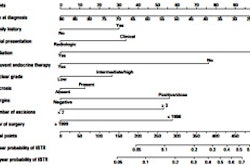Women with dense breasts who have ductal carcinoma in situ (DCIS) may be at higher risk for subsequent breast cancer, particularly in the opposite breast, according to a new study published online October 4 in Cancer Epidemiology, Biomarkers, and Prevention, a journal of the American Association for Cancer Research (AACR).
Researchers from Kaiser Permanente's division of research in Oakland, CA, conducted a study consisting of 935 women diagnosed with DCIS who were treated with breast-conserving surgery between 1990 and 1997. They found that risk of subsequent breast cancer appeared to be elevated among the women with higher-density breast tissue, comparable to the risk of breast cancer in women with dense breasts who don't have a history of the disease (Cancer Epidemiol Biomarkers Prev, October 4, 2010, Vol. 19:10).
"Our results provide additional supporting evidence for an increase in risk of second breast cancers among DCIS patients with mammographically dense breasts," wrote lead author Laurel Habel, PhD, and colleagues. "This association seems to be strongest and most consistent for risk of cancer in the contralateral breast ... and the association of risk of contralateral cancer is similar in strength to what has been previously reported for mammographic density and risk of primary breast cancer among women without a history of breast cancer."
Sixty percent of the study group was at least 55 years of age at the time of DCIS diagnosis; 75% were non-Hispanic white women. Most of the DCIS was found with routine screening mammograms, the authors wrote.
Of the 935 women included in the study, 164 (18%) had subsequent breast cancer in the original DCIS-affected breast, and 59 (6%) had a new primary cancer in the other breast during follow-up (median time, 103 months).
Women with the greatest total area of density (upper 20% of values) were at increased risk for invasive disease in either breast or any cancer (DCIS or invasive) in the ipsilateral or contralateral breast, compared to those with the smallest area of density (bottom 20%).
The study further confirms that a woman's breast tissue density is an important factor in her ongoing care, according to the researchers.
Our results "suggest that mammographic density assessment at diagnosis may aid in the prediction of risk for second cancers among women with DCIS," they concluded. "This information may be important to patients and doctors when making treatment decisions, especially given recent data suggesting increasing rates of contralateral prophylactic mastectomy in DCIS patients."
By Kate Madden Yee
AuntMinnie.com staff writer
October 7, 2010
Related Reading
New imaging tools address challenges of dense breast tissue, September 14, 2010
Vitamin D, calcium intake not linked to postmenopausal breast density, August 16, 2010
Researchers take a 3D approach to breast density, July 2, 2010
Conn. breast density law causes conundrum for mammo sites, April 29, 2010
Breast density linked to increased breast cancer risk, April 21, 2010
Copyright © 2010 AuntMinnie.com



















